Abstract
Forty patients with severe chronic stable airflow obstruction and hyperinflation were studied to assess patterns of abnormal chest wall motion and their frequency. Dimensional changes were measured during tidal breathing, four pairs of magnetometers being used to record anteroposterior diameters of ribcage and abdomen and two lateral diameters of the ribcage. Chest wall movements were qualitatively normal in only five patients. Three main types of abnormality were found and 13 subjects had two or more abnormal patterns. Lateral ribcage paradox was present in 31 of the 40 patients and was recognised clinically in all except one. Inspiratory indrawing of the lower sternum was recorded in 12 patients, paradoxical inspiratory motion of the abdomen was present in four patients and in six there was a biphasic expiratory pattern of abdominal movement. Analysis of variance showed no significant group differences in severity of airflow obstruction or hyperinflation between the patients with qualitatively normal motion and those with different types of abnormal motion. Relationships between the tidal displacement of each dimension and severity of airflow obstruction and hyperinflation were examined. In general, patients with more severe hyperinflation showed less abdominal movement and those with severe airflow obstruction had less lateral expansion of the ribcage, but the correlations were weak. It is concluded that abnormal motion of the chest wall is very common in patients with airflow obstruction and hyperinflation, that clinical recognition of abnormal motion other than lateral ribcage paradox is easily overlooked, and that quantitative relationships between abnormal motion and disease severity are weak.
Full text
PDF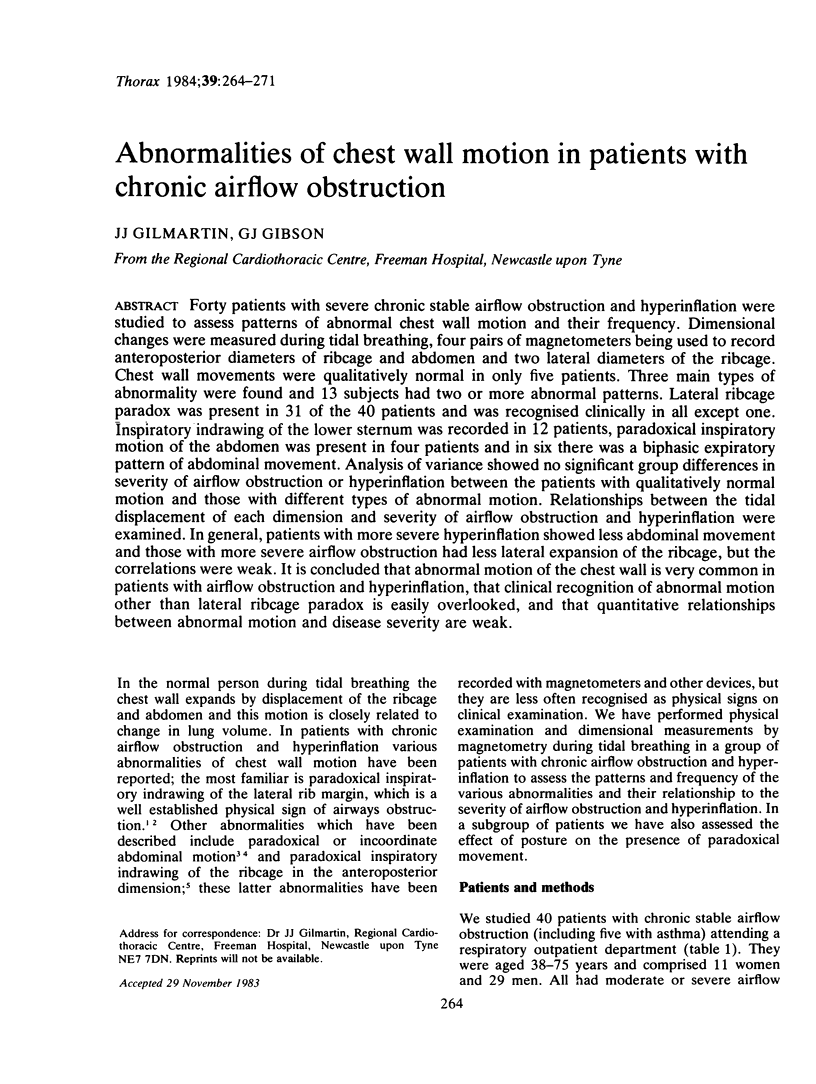
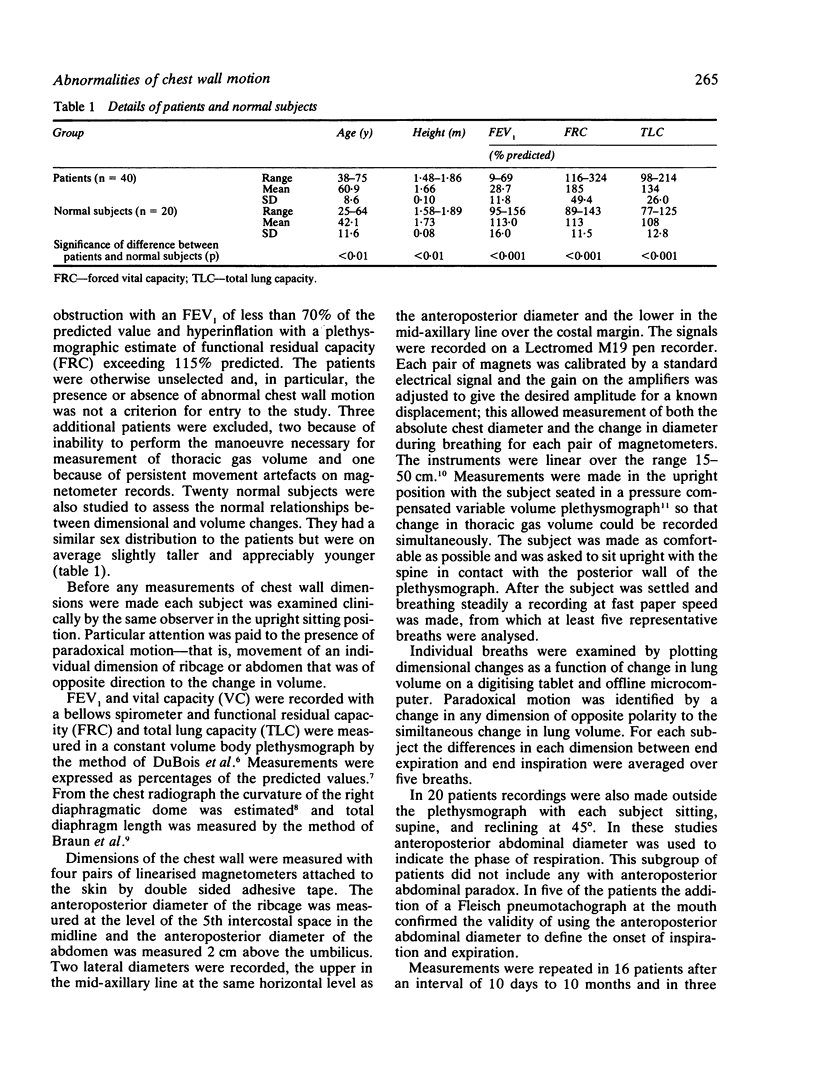
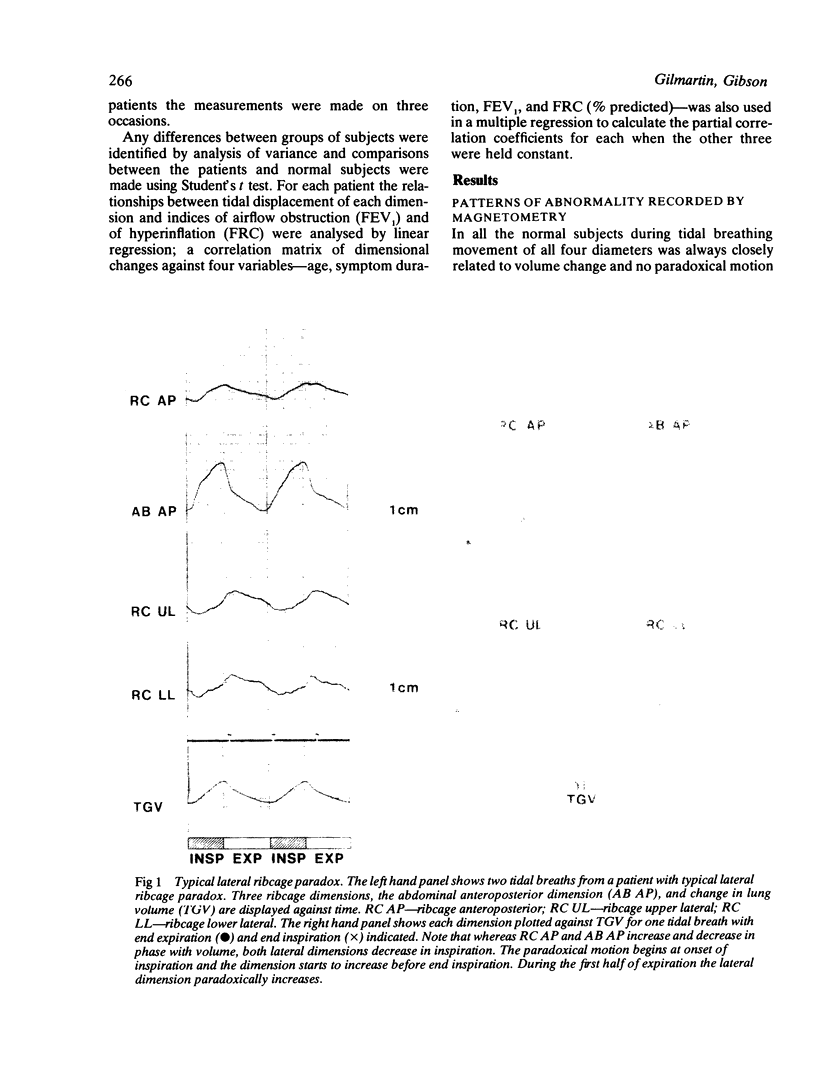


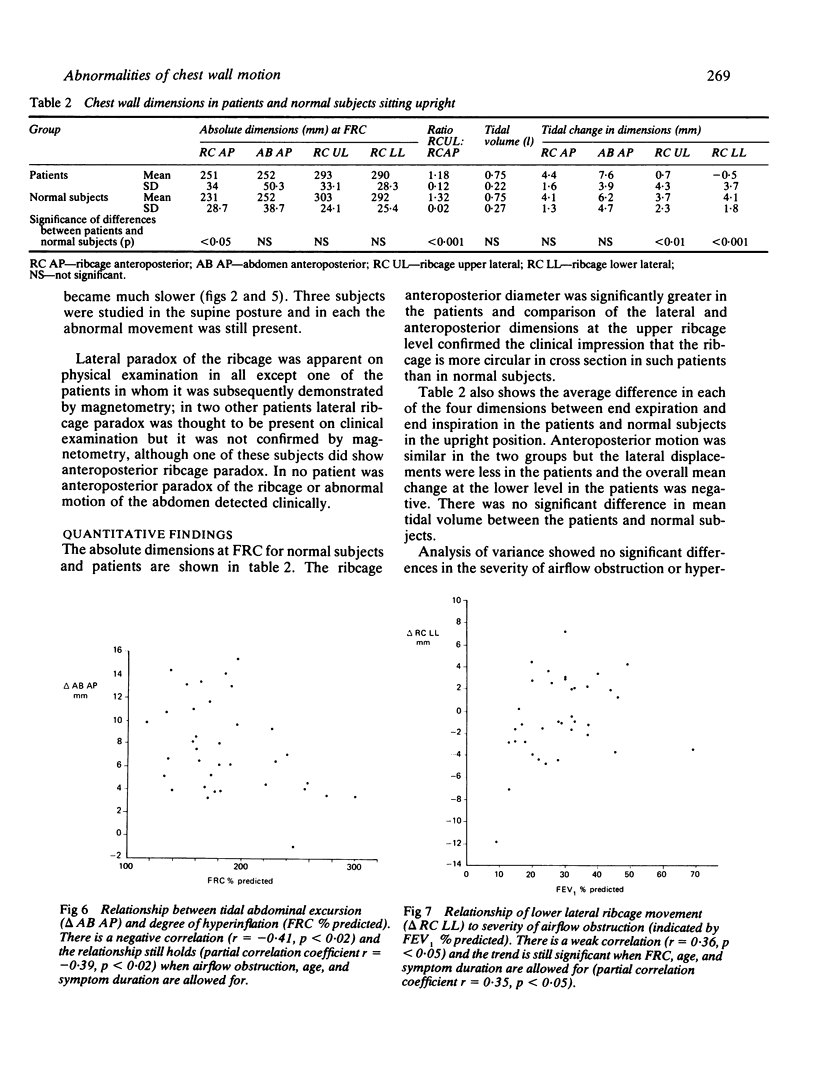
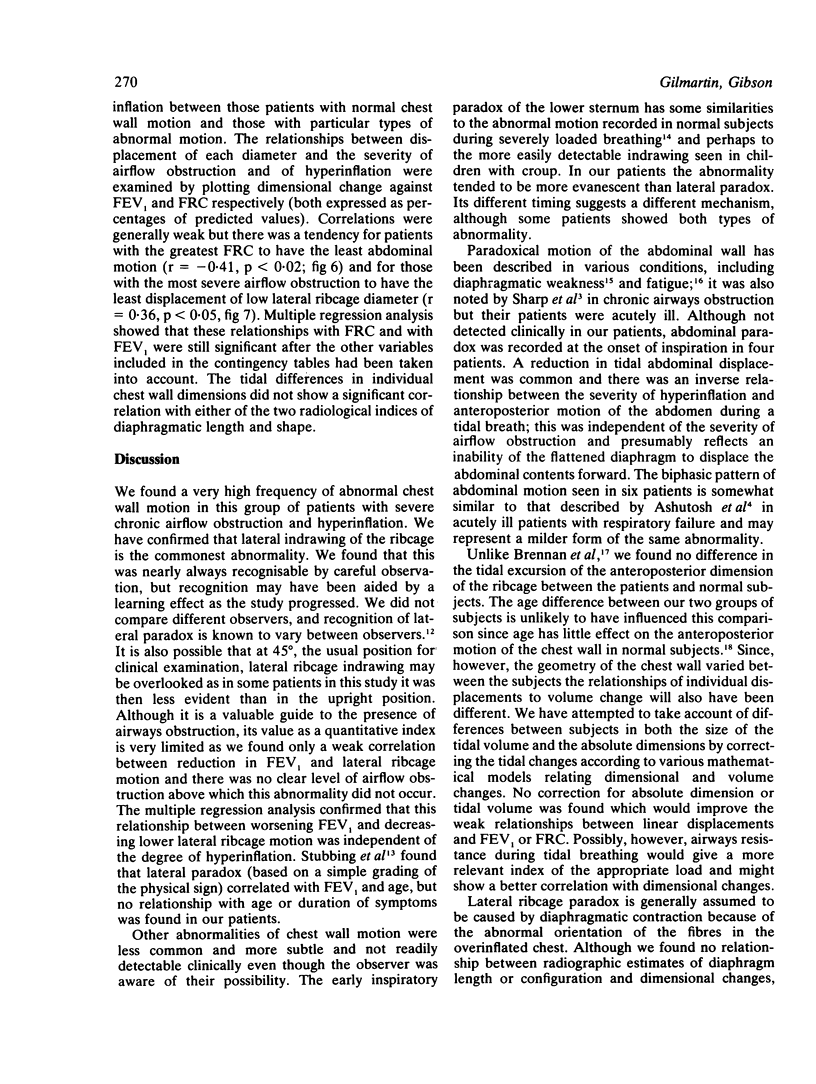
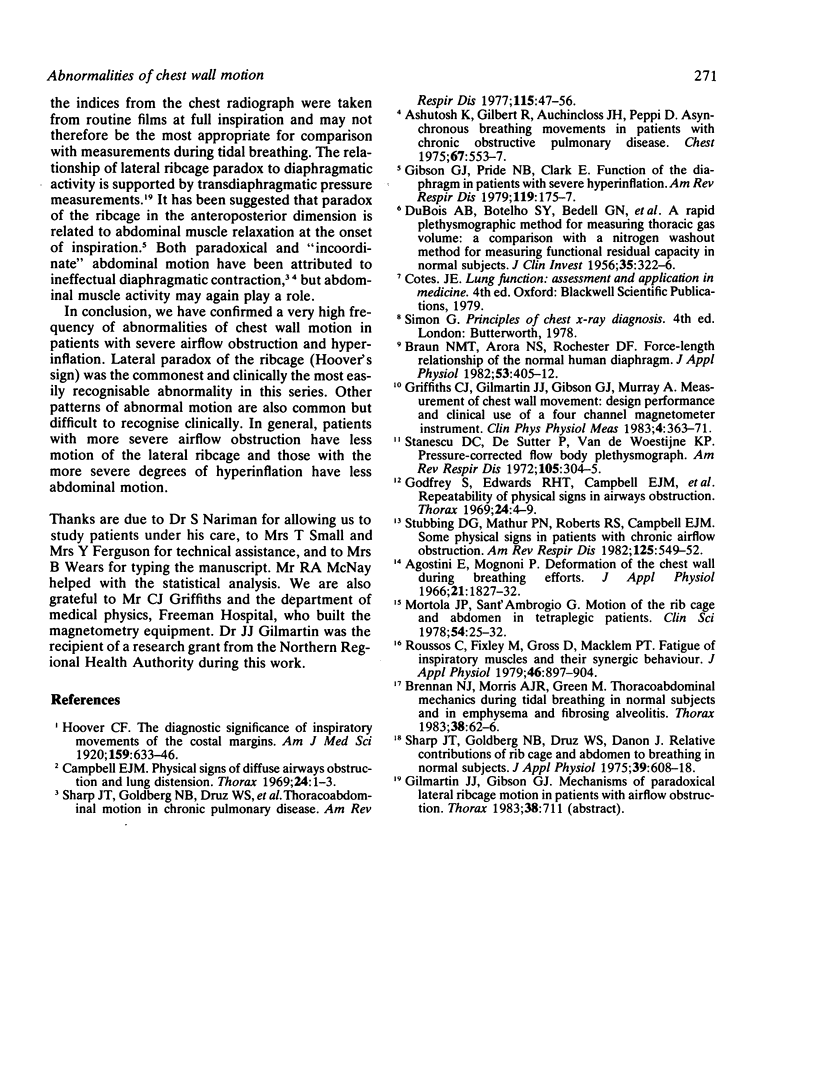
Images in this article
Selected References
These references are in PubMed. This may not be the complete list of references from this article.
- Agostoni E., Mognoni P. Deformation of the chest wall during breathing efforts. J Appl Physiol. 1966 Nov;21(6):1827–1832. doi: 10.1152/jappl.1966.21.6.1827. [DOI] [PubMed] [Google Scholar]
- Ashutosh K., Gilbert R., Auchincloss J. H., Jr, Peppi D. Asynchronous breathing movements in patients with chronic obstructive pulmonary disease. Chest. 1975 May;67(5):553–557. doi: 10.1378/chest.67.5.553. [DOI] [PubMed] [Google Scholar]
- Braun N. M., Arora N. S., Rochester D. F. Force-length relationship of the normal human diaphragm. J Appl Physiol Respir Environ Exerc Physiol. 1982 Aug;53(2):405–412. doi: 10.1152/jappl.1982.53.2.405. [DOI] [PubMed] [Google Scholar]
- Brennan N. J., Morris A. J., Green M. Thoracoabdominal mechanics during tidal breathing in normal subjects and in emphysema and fibrosing alveolitis. Thorax. 1983 Jan;38(1):62–66. doi: 10.1136/thx.38.1.62. [DOI] [PMC free article] [PubMed] [Google Scholar]
- Campbell E. J. Physical signs of diffuse airways obstruction and lung distension. Thorax. 1969 Jan;24(1):1–3. doi: 10.1136/thx.24.1.1. [DOI] [PMC free article] [PubMed] [Google Scholar]
- DUBOIS A. B., BOTELHO S. Y., BEDELL G. N., MARSHALL R., COMROE J. H., Jr A rapid plethysmographic method for measuring thoracic gas volume: a comparison with a nitrogen washout method for measuring functional residual capacity in normal subjects. J Clin Invest. 1956 Mar;35(3):322–326. doi: 10.1172/JCI103281. [DOI] [PMC free article] [PubMed] [Google Scholar]
- Gibson G. J., Pride N. B., Clark E. Function of the diaphragm in patients with severe hyperinflation. Am Rev Respir Dis. 1979 Feb;119(2 Pt 2):175–177. doi: 10.1164/arrd.1979.119.2P2.175. [DOI] [PubMed] [Google Scholar]
- Godfrey S., Edwards R. H., Campbell E. J., Armitage P., Oppenheimer E. A. Repeatability of physical signs in airways obstruction. Thorax. 1969 Jan;24(1):4–9. doi: 10.1136/thx.24.1.4. [DOI] [PMC free article] [PubMed] [Google Scholar]
- Griffiths C. J., Gilmartin J. J., Gibson G. J., Murray A. Measurement of chest wall movement; design, performance and clinical use of a four-channel magnetometer instrument. Clin Phys Physiol Meas. 1983 Nov;4(4):363–371. doi: 10.1088/0143-0815/4/4/001. [DOI] [PubMed] [Google Scholar]
- Mortola J. P., Sant'Ambrogio G. Motion of the rib cage and the abdomen in tetraplegic patients. Clin Sci Mol Med. 1978 Jan;54(1):25–32. doi: 10.1042/cs0540025. [DOI] [PubMed] [Google Scholar]
- Roussos C., Fixley M., Gross D., Macklem P. T. Fatigue of inspiratory muscles and their synergic behavior. J Appl Physiol Respir Environ Exerc Physiol. 1979 May;46(5):897–904. doi: 10.1152/jappl.1979.46.5.897. [DOI] [PubMed] [Google Scholar]
- Sharp J. T., Goldberg N. B., Druz W. S., Danon J. Relative contributions of rib cage and abdomen to breathing in normal subjects. J Appl Physiol. 1975 Oct;39(4):608–618. doi: 10.1152/jappl.1975.39.4.608. [DOI] [PubMed] [Google Scholar]
- Stanescu D. C., De Sutter P., Van De Woestijne K. P. Pressure-corrected flow body plethysmograph. Am Rev Respir Dis. 1972 Feb;105(2):304–305. doi: 10.1164/arrd.1972.105.2.304. [DOI] [PubMed] [Google Scholar]
- Stubbing D. G., Mathur P. N., Roberts R. S., Campbell E. J. Some physical signs in patients with chronic airflow obstruction. Am Rev Respir Dis. 1982 May;125(5):549–552. doi: 10.1164/arrd.1982.125.5.549. [DOI] [PubMed] [Google Scholar]



